
Is bottomless prosecco going to be killed off by climate change?
Picture this. The group chat has finally settled on a date and we are going out. Out out. Women of most ages know how serious this is. There was probably a spreadsheet involved. Boyfriends and husbands have been dispatched to the pub. Children and dogs have been dropped off at the sitter. Dignity has been left at the door. One of us is waiting for it to be cancelled so we can stay at home with our loungewear and girl dinners (it’s probably me). There’s only one thing for it. Bottomless brunch. Many Asos orders and outfit changes later, we arrive, take our seats and start the binge drinking timer. There’s only one problem. No prosecco. Freshly manicured fists pound the table. The elected Karen of the group starts to verbally pulverise the staff. Eggs Benedicts are thrown against the walls. The Prosecco Huns exclaim in unison: “But what are we going to drink now?!” The waiter bashfully suggests: “Spumante?” Give over. According to a new study, this could be a reality in the near future thanks to climate change threatening vineyards across Europe, in particular those dedicated to glera (the beloved prosecco grape) in Northern Italy. In a detailed report in iScience last month, researchers warned that unpredictable weather, soil degradation and drought could lead to the loss of a millennia-old winemaking tradition, and the livelihoods attached to it. RIP the Prosecco Hun. The Italian sparkling wine has long been the fizz of choice in the UK (we were only dethroned as the world’s biggest prosecco guzzlers last year by the US). In the early 2010s, more than a third of all the prosecco shipped out of Italy worldwide ended up in Britain – approximately 131 million bottles a year. That’s nearly two bottles per Brit. You get the idea. The origin of our obsession with prosecco dates back to just after the 2008 crash, when consumers were looking for an alternative to expensive champagne. The softer tasting, far more affordable (thanks to its cheaper and speedier production time) and incredibly quaffable prosecco was the obvious choice. Bottomless brunch was born. “My heart goes out to the huns whose weekends simply aren’t complete without a bottle of prosecco,” Hannah Crosbie, founder of Dalston Wine Club, laments at the news that just 15 years after it stormed onto supermarket shelves, prosecco might be quietly forced to say arrivederci. “In all seriousness though, climate change is seriously threatening every aspect of winemaking, and growing conditions are only getting more challenging.” Prosecco is certainly not the only vino at risk, but it faces a unique issue. Where other wine growing regions affected by climate change such as Champagne and Burgundy can simply put out a limited run with an inflated price tag and keep the snobby oenophiles coming, prosecco’s USP is its ability to produce in bulk and at a fraction of the cost. English sparkling is a big winner with the climate going the way it is. Prosecco, by all accounts, seems like it’s a bit of a loser in that regard Will Amherst, head wine buyer at Trullo Ali Finch, group sommelier at Angela Hartnett’s Michelin-starred Italian restaurant Murano in Mayfair, doesn’t believe there’s an appetite for a higher quality, more expensive prosecco. “With the impact of the climate as well as the cost of producing wine increasing, the challenge for prosecco is going to be how to balance the expectation of its price point with the need to make slightly smaller quantities,” she tells me. “Regions like Chablis, for instance, have had multiple horrible vintages back to back and people just accept the fact they have to pay more for it if they want to drink that wine.” For the uninitiated, the word “vintage” on a wine label simply means the year the grapes were harvested – compared to regular wines that may include grapes harvested in multiple years – and each vintage can taste vastly different based on the conditions affecting the grapes in that year. Chablis, produced from chardonnay grapes in the northernmost district of Burgundy, has always been particularly affected by the climate due to its geography, but in recent years has seen frost in 2016, 2017 and 2021, and drought and higher temperatures in 2019 and 2020. This has dramatically affected those vintages, and driven up the price of bottles from “good” years. But with prosecco, “people potentially wouldn’t be interested in” paying a higher price, Finch says. This is partly because its brand has become more associated with cheap fizz than fine wine in Britain. Part of the problem also lies in the simplicity of its production. Prosecco is a wine that reflects the aromatics of the grape at the point of harvest, whereas with other sparkling wines like champagne, as well as other types of wine in general, such as chablis, it’s about the ageing process. Rising temperatures mean grapes are ripening more quickly, which can result in a different flavour of wine or too much alcohol, so one option is to harvest the grapes earlier. You can get away with a slightly under-ripe fruit in aged wines as so much of the flavour is added during their long fermentations. In prosecco, a bottle of which is ready in just 30 days, an under-ripe grape could result in something that “tastes a lot like battery acid”, according to Finch. The Prosecco Huns don’t want to chug something flavourless and eye-wateringly alcoholic with their eggs Benedict. “If you pick too early, you’ve got no flavour,” Finch explains. “So they don’t really have the option to just keep making it in the same volume. With other wines, you can do more work in the winery to make the wine feel more balanced and more approachable and more complex. They don’t have that luxury in prosecco.” Under Italy’s DOC (Denominazione di Origine Controllata) laws, prosecco is only prosecco when it comes from just two regions of the country, Veneto and Friuli-Venezia Giulia, and adheres to strict growing and production rules. The same goes for champagne: only wine produced from eight permitted varieties of grape grown exclusively in the Champagne region of France may be called champagne. It’s these “heroic viticulture” sites that the report says are most at risk. Naming rights have been a point of contention across the whole wine industry for some time, with Australian producers of glera recently putting in a request to the EU to be allowed to call their wine prosecco on the grounds that it’s part of their migrant and cultural identity. Ironically, the glera grape is actually believed to be Slovenian in origin, and was first cultivated in the vineyards of Prosecco, a small village in the Friuli-Venezia Giulia region near the border with Slovenia. The name is even thought to derive from the Slovenian words preseka or poseka, or the Serbian/Croatian prosek, meaning “path cut through the woods”. While DOC laws might prevent anyone calling a sparkling wine made from glera grapes outside of the designated regions a prosecco, it hasn’t stopped winemakers around the world from essentially producing the same wine using the same techniques. As climate change has made it increasingly difficult to cultivate the grapes in their historical home, it’s also made conditions in more northern regions like the UK more favourable for the growing of certain grapes, including white varieties such as glera, opening the door to a whole new generation of winemakers. “This is not me saying this is the death of prosecco,” Finch adds quickly, but she stresses that the wine industry is naturally very dynamic. “There are loads of alternatives to prosecco, both within Europe in terms of pet nats and cremants and things like that, and with the New World as well.” Pet nats – sparkling wines made using the “traditional method” of fermenting in individual bottles – have become very trendy among the younger Gen Z crowd, she says, as it still offers something bright, fruity and super fizzy, but without the faff, or price tag, that comes with champagne. People are also drinking less but are happy to spend a little more and not drink as much. At Murano, Finch says diners are asking about English sparkling wines more than ever before. “The correlation, obviously, with post-Brexit is there. There’s a desire to try and drink more local wines, potentially from a sustainability point of view, potentially from a cost-to-quality point of view because of duty increasing. It’s also partly because during Covid people did a lot of staycations and UK wine tourism did very well during that time. And it sort of stuck.” It’s a sentiment echoed by Will Amherst, head wine buyer at Italian trattoria Trullo in Islington, north London. “I don’t want to bash prosecco too much, but if I was going out and I wanted sparkling wine, I would still look at champagne,” he says, much to the chagrin of the Prosecco Huns. “And if I’m going to look somewhere other than that, I would get a bottle of English sparkling. Because English sparkling is a big winner with the climate going the way it is. Prosecco, by all accounts, seems like it’s a bit of a loser in that regard.” Prosecco and the people that produce it are certainly not the only losers but its high-altitude, cooler temperature geography, which previously protected it from climate change, is now adversely affected by extreme weather. Sudden, intense rainfall damages the soil and creates “slope failures”, while conversely droughts make irrigation extremely difficult. While he’s yet to see a knock-on effect on prosecco supplies at Trullo, Amherst’s “immediate thoughts were, really sadly: is prosecco going to be able to pull itself out of that hole? I don’t know how you reconcile the spiralling production costs and the brand identity, which is synonymous with cheap wine in this country,” he says. Although it’s not recommended to keep prosecco longer than two to three years before it goes flat – compared to up to 10 years for vintage champagnes – he doesn’t anticipate stocks to run down soon. At any rate, his biggest use for prosecco at Trullo is in an Aperol Spritz, where it makes up half the drink. He actually sees it as an exciting opportunity for new wines to emerge. So does Will Hill, a wine buyer at online merchant Honest Grapes, who tells me: “Once again, cava is showing that there is great value to be found in traditional method sparkling wines and more and more we are seeing ‘prosecco-esque’ wines for lower prices. If the consumer isn’t tied to the name ‘prosecco’, there are plenty of good, affordable, entry-level options available.” It’s clear that wines of all colours are facing an uphill battle (quite literally in prosecco’s case), not just to survive but to protect their identity, which for prosecco is arguably more important. That could spell the end of the Prosecco Hun, but with English sparkling and other European varieties on the rise, perhaps it just means a rebranding is in order. Cremant Crew? Pet Nat Posse? They don’t have quite the same ring, but it won’t stop us booking bottomless brunch anytime soon. Read More I feel it in my fingers: Why more of us should start eating with our hands Pizza, cake and meringue martinis: When did cinema food get so silly? Michelin-starred chef Simon Rogan on 20 years of L’Enclume: ‘It all started with a radish’
2023-09-06 15:29

Hermine Dossou: Being thrifty in the kitchen helped me get on the housing ladder
As a trained accountant and a long-time baking enthusiast, Hermine Dossou knows a thing or two about saving money in the kitchen. “My first breadmaker was from Panasonic – I bought it from Gumtree,” the former Great British Bake Off contestant says. “It was basically somebody’s wedding present that they didn’t want and they sold it half price.” A devotee of Martin Lewis’s Money Saving Expert website, the 42-year-old, who was born in Benin, West Africa, and moved to the UK for university aged 20, tries to avoid ever paying full price for a big ticket item. “If I wanted to buy, let’s say, a mixer, I would go online, and type ‘Kenwood discount vouchers’ and then something always comes up,” says Dossou, who lives in Kettering and came fourth on the 2020 series of Bake Off. But the mum-of-one – whose son Steven is 13 – wasn’t always such a frugal foodie. “That came from that period where I became a single mum on a reduced income,” she says. “I couldn’t work full-time because I had to look after my son, and also I didn’t want him to have the processed kind of bakes.” Whipping up cakes and cookies filled her “empty afternoons” as a new mum and was a lot cheaper than buying ready-made baked goods. “I would cook from scratch and prep my vegetables when I could get them on offer,” she continues. “Same for fruits – they are often very discounted when they become a bit soft, and that’s the best time to make jam.” Even post-Bake Off and her book deal (she works full-time as an accountant), Dossou remains a savvy shopper, knowing that a higher price doesn’t always mean a better product. “Like a bar of chocolate, if it’s the same quantity of cocoa, why are you paying three times the price? Especially if you’re going to bake with it. “Wonky onions at half the price is the same… they all come from the same farm.” Her accountancy skills came in handy, too, and she still uses a spreadsheet to track her income and outgoings every month. “I think generally in life it is important to budget and know where your money goes, because I think it allows you to achieve a lot more than if you were just living freestyle,” Dossou says. “It’s a nightmare trying to get on the housing ladder here in the UK – that’s something I’ve been able to do through being thrifty in every area of my life.” That’s why she decided to call her first cookbook The Thrifty Baker: “I just really wanted to bring that awareness of how we choose what we eat, and how we can save through making little changes here and there.” “Now, more than ever, when people are struggling with the cost of living, I think it’s even more important to go back to those values of cooking from scratch, trying to cook at home, and making meals from, you know, not much.” With lots of advice for beginners, the book focuses on affordable dishes, from basic breads and simple biscuits to special occasion puds and impressive-looking desserts. There’s a distinct Gallic influence (Benin, where Dossou learned to bake as a child, is a former French colony) felt with recipes such as pain de campagne, orange and brown butter madeleinesm and pear frangipane tart. The author points out when a recipe can be cooked in an air fryer – a recent Black Friday bargain she loves because it allows her to enjoy fried Benin delicacies using less oil and without turning on the oven. “Because we have a really small family, just me and my son, you don’t always want to put the oven on just to bake something for two. “With an oven you’ll need to preheat it for a good 15 to 20 minutes before you can even bake in it. With the air fryer you just put the cake in and 15 minutes later it’s out – easy and convenient.” There’s also a section devoted to microwaveable mug cakes, with peanut butter and jam, speculoos (aka Biscoff) and chocolate hazelnut flavours of the cheap and easy-to-make single-serve puds. “In the microwave you can make a cake in five minutes from weighing, mixing and baking,” says Dossou, who loves how kid-friendly they are. “With my son I feel more inclined to let him make a mug cake than maybe something bigger. “Even if it goes wrong he’s not wasting a lot of ingredients and, you know, he’s not turning the kitchen into a bonfire.” ‘The Thrifty Baker’ by Hermine Dossou (White Lion, £18.99).
2023-09-06 13:58
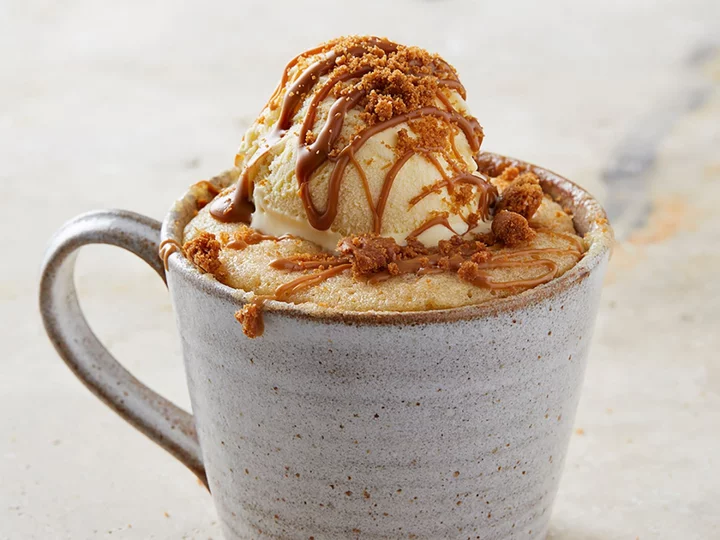
For a quick sugar fix, try this Biscoff microwave mug cake
Microwave cakes will never replace an oven-baked cake, in my opinion, because good things take time to create,” says former Great British Bake Off contestant, Hermine Dossou. “That said, when you don’t have an oven, when you’re not in your own kitchen with your own equipment, when you’re limited by time, or even have just a few bits of ingredients here and there, microwave mug cakes make a great substitute. And they’ll help you get rid of that sugar craving!” Speculoos mug cake Serves: 1 Ingredients: 30g salted butter 1 tsp speculoos spread 40g sugar 25g whole milk 1 small egg 40g self-raising flour 1 tsp vanilla extract For the topping: 1 tbsp speculoos spread 1 scoop vanilla ice cream 1 speculoos or other biscuit, for crumbling Method: 1. Put the butter and speculoos spread in a large mug and microwave on medium–high power (600 watts) for 10-20 seconds. Stir until smooth. 2. Add the sugar and milk and stir until combined. Then add the egg and mix vigorously with a whisk or small spatula to avoid streaks of egg white in your cake. 3. Finally, add the flour and vanilla, mixing thoroughly to ensure there are no lumps. 4. Microwave on medium–high (600 watts) for one minute. Keep an eye on the cake as each microwave cooks differently. You want the batter to be only just cooked; when you lightly touch the top, it should feel slightly sticky. If it feels completely dry, you have overcooked your cake. Remove from the microwave and allow to cool. 5. To serve, melt the one tablespoon of speculoos spread in the microwave for about 10 seconds. Top the cake with a scoop of vanilla ice cream, drizzle with the melted speculoos spread and sprinkle with the crumbled biscuit. Enjoy. ‘The Thrifty Baker’ by Hermine Dossou (White Lion, £18.99).
2023-09-06 13:54
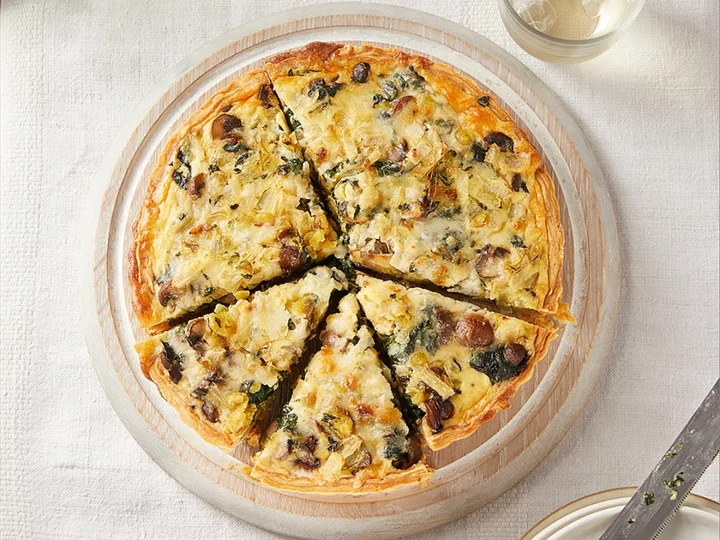
How to make spinach and mushroom quiche
It’s often said that quiche is old-fashioned, but there is nothing old-fashioned about this one,” says former Great British Bake Off contestant Hermine Dossou. “It’s a crumbly, super-short, melt-in-your-mouth pastry filled with buttery spinach and creamy custard. “Gruyère is the perfect cheese for quiche and a little goes a long way, but if it’s not available, you can substitute with Emmental, Comté, Jarlsberg or Beaufort.” Spinach and mushroom quiche Serves: 8 Ingredients: For the shortcrust pastry: 210g plain flour (gf plus 1 tsp xanthan gum), plus extra for dusting 130g cold butter 1 large egg (55g) 1 tbsp cold water ¼ tsp salt For the custard: 15g butterLeaves from 3 thyme sprigs 1 small yellow onion (about 50g), finely chopped 2 eggs 120g double cream 1 chicken or vegetable stock cube, crumbled 1 tsp Dijon mustard ¼ tsp salt Pinch of black pepper For the filling: 30g butter 250g mushrooms, sliced ½ tsp garlic powder A pinch of salt 250g baby spinach leaves 80g grated Gruyére cheese Method: 1. To make the shortcrust pastry, in a large bowl rub the flour and butter together with your fingertips until sandy in texture. (You can use a food processor to speed up this process.) Add the egg, water and salt and bring together into a dough without overworking it. Wrap in cling film and chill in the fridge – you always want to work with cold pastry as it’s much easier to handle. 2. When ready, lightly flour a work surface and roll out the dough to a circle about 30cm in diameter and 3mm thick. Use your rolling pin to lift it up and lay it over a 23cm tart tin, so there is an overhang of pastry at the top. Using a straight-sided glass, ease the pastry into the corners of the tin by rolling the glass around the edge in circular motion. Chill for 20 minutes. 3. Preheat your oven at 200C/180C fan/400F/Gas 6. Line your chilled pastry case with parchment paper, fill it with baking beans or cheap pulses, and blind bake for 15 minutes. Lift out the baking beans and parchment paper and continue baking for a further 10 minutes to dry out the base. 4. Meanwhile, make the custard. Put the butter, thyme and onion in a small frying pan over medium heat and cook until the onion is soft and transparent. Set aside to cool slightly. In a medium bowl, whisk together the eggs, cream, stock cube, mustard, salt and pepper, adding the cooked onions. Set aside. 5. Prepare the filling using the same pan you used to cook the onions. Heat the butter, add the mushrooms, garlic and salt, and cook over a high heat until the mushrooms are soft and most of the water has evaporated. Add the spinach and cook until it has wilted and the mixture is thick. 6. Tip the spinach mixture into the pre-baked tart case and spread it around evenly. Sprinkle over the grated cheese, then pour in the custard, making sure it’s distributed evenly. Bake at 200C/180C fan/400F/Gas 6 for 20–25 minutes, or until the middle of the quiche looks set and the top is slightly golden. Enjoy warm. ‘The Thrifty Baker’ by Hermine Dossou (White Lion, £18.99).
2023-09-06 13:50
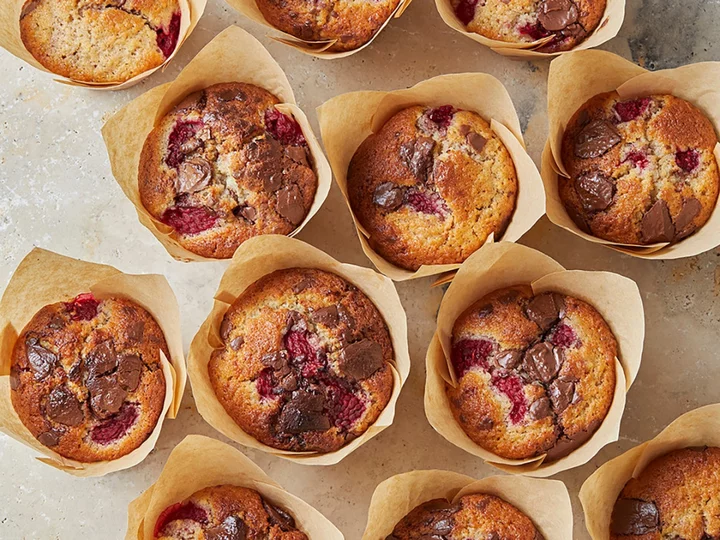
Thrifty and fruit coconut, raspberry and chocolate muffins
The combination here tastes wonderful whether you’re using fresh raspberries in season (when they’re cheaper) or frozen raspberries,” says former Great British Bake Off contestant Hermine Dossou. “To enhance the flavour of your desiccated coconut, you could toast it lightly (for five minutes or so) while preheating the oven – but keep an eye on it as it does turn brown very quickly.” Coconut, raspberry and chocolate muffins Makes: 12 Ingredients: 180g milk 2 large eggs 60g vegetable oil 60g unsalted butter, melted 230g sugar 1 tsp vanilla extract ½ tsp ground cinnamon ½ tsp ground nutmeg 5g salt 250g plain (all-purpose) flour (gf plus ½ tsp xanthan gum) 80g desiccated (dried shredded) coconut 10g baking powder (gf) 150g raspberries 150g milk chocolate, chopped into chunks Method: 1. Preheat the oven to 200C/180C fan/400F/gas 6 and line a 12-hole muffin tin with paper cases. 2. In a large mixing bowl, mix together the milk, eggs, oil, butter, sugar, vanilla, cinnamon, nutmeg and salt for about a minute, until well combined. Add the flour, coconut and baking powder and stir until fully incorporated. Fold in half the raspberries and all the chocolate chunks. 3. Divide the batter equally between the muffin cases. Top each muffin with a couple of the remaining raspberries. Bake for 25–30 minutes, or until the muffins have risen and are golden brown. You can keep these for a few days in an airtight container, or, once cooled, freeze them for up to 3 months. They are lovely served warm – either out the oven or reheated for a few seconds in the microwave. ‘The Thrifty Baker’ by Hermine Dossou (White Lion, £18.99).
2023-09-06 13:50

UN forced to cut food assistance from 10 million Afghans
As of September, 10 million Afghans have lost assistance from the World Food Programme this year, the organization announced this week.
2023-09-06 06:18
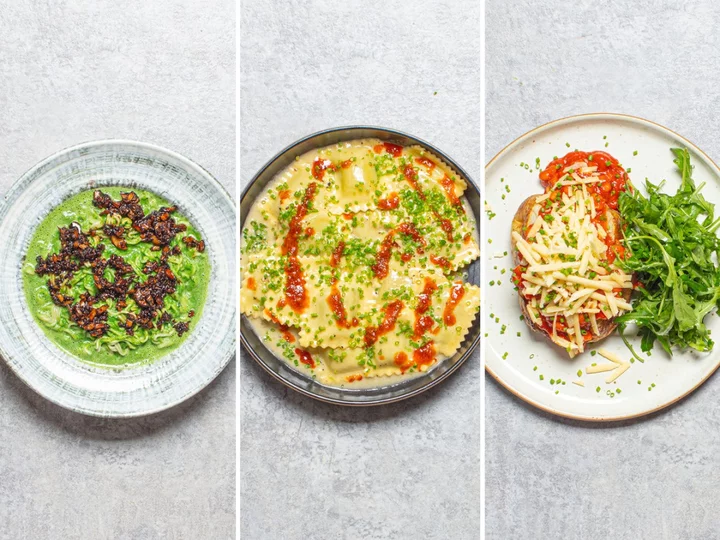
Three ways to pimp up university student classics
As teenagers start or head back to university this month, we’ve found three ways to level up student classics: instant ramen, ravioli and baked beans. Pre-made food has never tasted this good. As part of our Budget Bites column – where we’ve teamed up with Sorted Food to bring you easy, affordable, quick and (most importantly) tasty recipes once a month – this month’s instalment is all about dishes that make the most of staple ingredients while keeping your fresh shopping list minimal. We’ve also provided a handy shopping list for the ingredients (though hopefully most of it will be knocking about already), which are used across all recipes to ensure minimal food waste. You just need to decide where to shop, whether it’s locally or online. Shopping list 2 baking potatoes (large) 6 cloves garlic 20g fresh ginger 20g fresh chives 60g rocket 200g fresh spinach 200g chestnut mushrooms 125g cheddar 30g unsalted butter 250g spinach and ricotta ravioli 2 instant ramen packets 400g tinned baked beans 1.5 tbsp gochujang 3 tbsp sesame oil 3 tbsp vegetable oil 1 tbsp cider vinegar 1 tsp mild chilli powder 1 tbsp tahini 2 tbsp light soy sauce 1 tsp honey Instant green ramen with sticky soy minced mushrooms If you aren't a fan of mushrooms, try replacing them with crumbled firm tofu. Serves: 2 Ingredients: 200g chestnut mushrooms 3 tbsp vegetable oil 2 instant ramen packets 2 cloves garlic 200g fresh spinach 20g rocket 1 tbsp tahini 2 tbsp light soy sauce 1 tsp honey Method: 1. Fill the kettle with water and put it on to boil, this will be for the broth and noodles later. 2. Mince 200g of mushrooms on a chopping board like you might chop herbs, until rice-like in size. You can use a food processor here if you are low on time. 3. Add 3 tbsp of oil to a large frying pan and place it over a high heat. 4. Once the oil starts to shimmer and loosen, add the mushrooms. Fry, tossing occasionally for 8-10 minutes, until golden in places. Get on with the rest of the dish in the next steps while you wait. 5. Tip the flavour sachets from 2 packets of instant noodles into a medium saucepan. Peel, then finely grate in 2 cloves of garlic and add 700ml of boiling water from the kettle. 6. Place the pan over a high heat, then add 200g of spinach and 20g of rocket. Boil for 4-5 minutes, stirring occasionally until the spinach wilts, darkens, and softens fully. Get on with the rest of the dish in the next steps while you wait. 7. Add the noodles from the packets to another medium saucepan and cover with boiling water from the kettle. 8. Place the pan over a high heat and boil for 2-3 minutes, until soft but still with a slight bite. Get on with the rest of the dish in the next steps while you wait. 9. Once the spinach has darkened and wilted, take the pan off the heat, add 1 tbsp of tahini and blitz until smooth and bright green with a hand blender. You have made your green broth! 10. Once the noodles are ready, use tongs to transfer them straight into bowls. Pour over the green broth and turn your attention back to the mushrooms. 11. Add 2 tbsp of soy sauce and 1 tsp of honey to the mushrooms. Cook over a high heat for 1-2 minutes, tossing regularly, until dark and sticky. 12. Spoon the mushrooms over the noodles and tuck in! Pre-made ravioli cheddar cacio e pepe We use spinach and ricotta ravioli in this recipe, but feel free to get creative and use different pre-made filled pastas. Serves: 2 Ingredients: 75g cheddar 10g fresh chives 30g unsalted butter 2 cloves garlic 1 tsp mild chilli powder 250g spinach and ricotta ravioli Method: 1. Fill the kettle with water and put it on to boil. This will be for the pasta later. 2. Coarsely grate 75g of cheddar, then finely chop 10g of chives crossways on the same board - we will need these later. 3. Melt 15g of the butter in a small pan over a low heat. 4. Once the butter starts to foam, peel and finely grate in 2 cloves of garlic and add 1 tsp of mild chilli powder. Take the pan off the heat and allow everything to cook and infuse in the residual heat while you get on with the rest of the dish in the next steps. 5. Add 250g of ravioli to a medium saucepan and cover with boiling water from the kettle. Place the pan over a high heat. 6. Cook for 3-4 minutes, until the pasta is soft and the filling is piping hot. Get on with the rest of the dish in the next steps while you wait. 7. Grind 1 tbsp of pepper into a large frying pan, toast it over a medium heat for 2-3 minutes, tossing occasionally, until fragrant. 8. Add the remaining 15g of butter to the pepper and allow it to melt in the pan. 9. Once the ravioli is ready, use a slotted spoon to transfer it to the pan with the pepper and butter. Toss and swirl everything to create a loose emulsion of the butter and pasta water around the ravioli. 10. Take the pan off the heat and toss through the cheese - add a splash of pasta water if it starts to look a little sticky or thick. We are looking for a loose emulsion of the cheese, butter, and pasta water at this stage. 11. Divide the pasta between plates. Drizzle over the garlic chilli butter and scatter over the chives. Gochujang baked bean jacket potatoes These levelled-up baked beans also taste great on toast or wrapped in crispy puff pastry! Serves: 2 Ingredients: 2 baking potatoes (large) 400g tinned baked beans 1.5 tbsp gochujang 2 cloves garlic 20g fresh ginger 3 tbsp sesame oil 50g cheddar 10g fresh chives 40g rocket 1 tbsp cider vinegar Method: 1. Preheat the oven to 230C. 2. Stab 2 baking potatoes all over with a fork. Cook in the microwave on full power for 10-12 minutes, until soft throughout. Flip them over halfway through to ensure an even cooking. Get on with the rest of the dish in the next steps while you wait. 3. Add 1 400g tin of baked beans to a medium saucepan. Add 1 ½ tbsp of gochujang, then peel and finely grate in 2 cloves of garlic and 20g of ginger. 4. Place the pan over a low heat, slowly bring the beans up to a simmer, and cook for 4-5 minutes, until piping hot. 5. Once the potatoes are ready, transfer them to a small baking tray. Rub with 2 tbsp of the sesame oil and a generous pinch of salt. 6. Bake in the oven for 8-10 minutes, until the skin is crisp and golden. Get on with the rest of the dish in the next steps while you wait. 7. Coarsely grate 50g of cheddar, then finely chop 10g of chives crossways on the same board. 8. Add 40g of rocket to a large mixing bowl, toss with 1 tbsp of sesame oil, 1 tbsp of vinegar, and a pinch of salt. If you are still waiting for the potatoes, now would be a great time to crack on with a bit of washing up. 9. Once the potatoes are ready, split them lengthwise in half and fill with the baked beans. Scatter over the cheese, chives, and serve with the salad. In response to the rising cost of living, we have teamed up with Sorted Food to bring you easy, affordable, quick and (most importantly) tasty recipes once a month. Find out more about Sorted and their nifty meal-planning app Sidekick at sortedfood.com/sidekick. Read More Epicurus: American fast food meets the Middle East in Camden Market The dish that defines me: Evelin Eros’s rum cake ‘It started with a radish’: Chef Simon Rogan reflects on restaurant L’Enclume at 20 The true story – and murky history – of Portuguese piri piri oil ‘My depression stopped me doing what I loved most in life – cooking’ What Bake Off’s Jurgen Krauss really thinks of his shock elimination
2023-09-05 20:25

Time Lapse Video Reveals How Long it Takes a Watermelon to Decompose
If you've ever wondered how long it takes a whole watermelon to decay, this timelapse video has the answer.
2023-09-05 05:25

‘Wrong number’ couple fight India deportation
Pakistani Gulzar Khan and his wife want to stay together after he married her illegally in India.
2023-09-05 05:19

The Surprising Inspiration Behind In-N-Out's Crossed Palm Trees
The trees make an 'X' at almost every In-N-Out location. And yes, it's by design.
2023-09-05 03:23
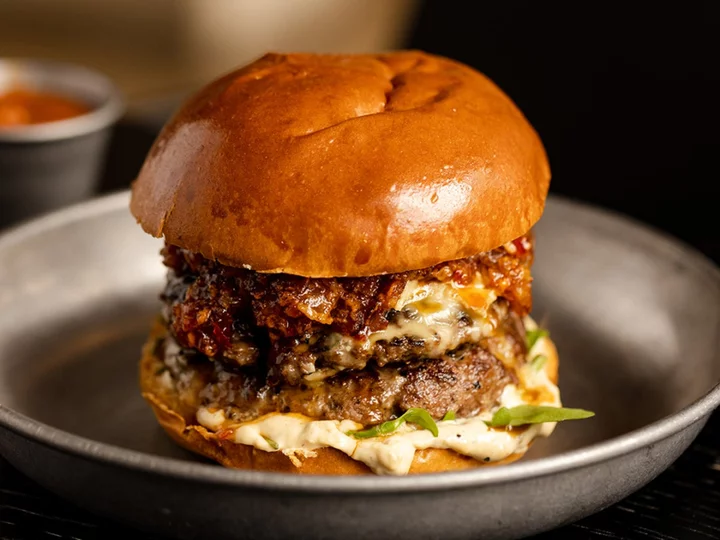
Epicurus: American fast food meets the Middle East in Camden Market
Camden has long been known as the spiritual home for misfits. Come, all ye oddballs, the streets of Camden scream. All are welcome! Although nowadays it’s a little less punk haven and a little more tourist trap (yes, I’m looking at you, pastas dunked into cheese wheels), there are still pockets of Camden that have retained its unconventional charm. It’s also where punky pair and Israeli chefs Shiri Kraus and Amir Batito have set up shop for both their restaurants, The Black Cow and the newer Epicurus, just minutes away from each other. Like The Black Cow, modeled after the classic American steakhouse but infused with Middle Eastern flavours, Epicurus takes its culinary cue from across the pond. This time, Kraus and Batito decided to focus on the all-American diner and put their Israeli twist on classics like pancakes, wings and ribs. When I ask if this is because American food is a bit of a blank slate, Kraus swiftly corrects me; to her, it’s all about the excitement of infusing the character of American cuisine with Israeli flavours and seeing what’s possible. It’s a pairing that I think is unusual, but to the chefs, makes perfect sense. It’s a warm, balmy day when I make my way to Epicurus to meet my friend, as well as Kraus and Batito. The outdoor space is placed tantalisingly in the late afternoon sun, so we bask in it as our tiny table fills up with more plates than is sensible. The quirky menu features punny dish names like “Chip Chip Hooray”, “Raspoutine”, “Top Dog” and “Sloppy Yossef”, which I find immediately endearing – my love for a good (or even bad) puns knows no bounds. We are instructed to eat as many things as possible with our hands, although Kraus concedes: “You could use a fork, I’ll only judge in silence.” We find delight in the “Oof Gozal” – chicken wings coated in a yellow Amba mango and Scotch bonnet sauce. Despite the use of the fearsome chilli, these wings are barely spicy, favouring the flavour of the Scotch bonnet over the heat. They are incredibly moreish and the fact that your fingers end up being absolutely covered in sauce is only an invitation to get licking. You should also definitely get the “Papi Chulo”, a mix of crunchy deep-fried okra and soft padron peppers covered in spices that come with a lemony-garlicky-chilli aioli for dipping. It’s brilliant for snacking on in the sun. Another honourable mention goes to the Epicurus single decker burger, which is also available as a double. It contains some of the richest, fattiest ingredients I’ve ever seen between buns, like bone marrow aioli and Baron cheese, and it does border on being a bit too unctuous. The Harissa bacon jam helps pull it back a little, but only just. Would I eat it again? Definitely. But I probably would get a salad instead of chips to make myself feel slightly better about ingesting all that fat. I am usually glad when menus don’t have calorie counts – even when they do, I avert my gaze determinedly – and boy, am I really glad there’s no calorie count on this menu. Not everything hits the spot, which I’m hoping Kraus and Batito will be able to tweak until they do. The “Dakdakim”, pancakes stuffed with pulled shawarma chicken, has the trappings of something great, but the addition of both bacon jam and spiced quince make the dish too sickly sweet. Meanwhile, the rack of babyback ribs covered in a deliciously tart-yet-sweet date honey and pomegranate molasses needs a bit more fat on the bones to make it truly delectable – otherwise the mouth-puckering quality of the sauce make the too-lean ribs a bit too dry to really enjoy. But these are small gripes, and ones that I’m happy to forgive if they are improved upon. Is it worth elbowing your way through the thronging crowds of Camden Lock Market to get to Epicurus? I think it will be. Never mind the cheap tat and endless boba tea shops (most of which are simply not very good, there are better places to visit boba tea that isn’t just a sugar bomb) – head to Epicurus for a tasty escape. Epicurus, Unit 90, Camden Stables Market, Greater, London NW1 8AH | www.epicuruscamden.co.uk | 07843 199560 Read More Dorshi, Dorset: Funky Malaysian dumplings are a hit on the south coast National Burger Day 2023: The best burgers in London and where to eat them The best outdoor restaurants, terraces and rooftop bars in London to book now
2023-09-02 19:20

Get Paid $600 to Eat Cake and Watch ‘The Great British Baking Show’
What better way to celebrate a new season of 'The Great British Bake Off' than by sampling 12 classic British baked goods for cash?
2023-09-01 03:21
